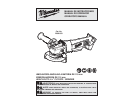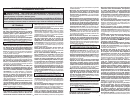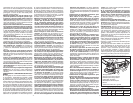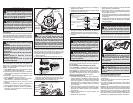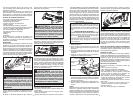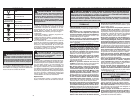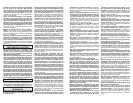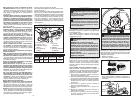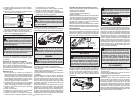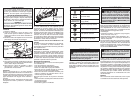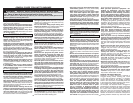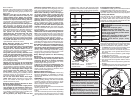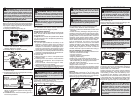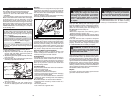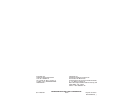
22
23
these conditions.
Kickback is the result of power tool misuse and/or
incorrect operating procedures or conditions and
can be avoided by taking proper precautions as
given below.
• Maintain a fi rm grip on the power tool and
position your body and arm to allow you to
resist kickback forces. Always use auxiliary
handle, if provided, for maximum control over
kickback or torque reaction during start-up.
The operator can control torque reactions or kick-
back forces, if proper precautions are taken.
• Never place your hand near the rotating acces-
sory. Accessory may kickback over your hand.
• Do not position your body in the area where
power tool will move if kickback occurs. Kick-
back will propel the tool in direction opposite to
the wheel’s movement at the point of snagging.
• Use special care when working corners,
sharp edges etc. Avoid bouncing and snag-
ging the accessory. Corners, sharp edges or
bouncing have a tendency to snag the rotating
accessory and cause loss of control or kickback.
• Do not attach a saw chain woodcarving blade
or toothed saw blade. Such blades create fre-
quent kickback and loss of control.
Safety Warnings Specifi c for Grinding and
Abrasive Cutting-Off Operations:
• Use only wheel types that are recommended
for your power tool and the specifi c guard
designed for the selected wheel. Wheels for
which the power tool was not designed cannot
be adequately guarded and are unsafe.
• The guard must be securely attached to the
power tool and positioned for maximum safe-
ty, so the least amount of wheel is exposed
towards the operator. The guard helps to pro-
tect the operator from broken wheel fragments
and, accidental contact with wheel and sparks
that could ignite clothing.
• Wheels must be used only for recommended
applications. For example: do not grind with
the side of cut-off wheel. Abrasive cut-off wheels
are intended for peripheral grinding, side forces
applied to these wheels may cause them to shatter.
• Always use undamaged wheel fl anges that
are of correct size and shape for your se-
lected wheel. Proper wheel fl anges support
the wheel thus reducing the possibility of wheel
breakage. Flanges for cut-off wheels may be dif-
ferent from grinding wheel fl anges.
• Do not use worn down wheels from larger
power tools. Wheel intended for larger power
tool is not suitable for the higher speed of a
smaller tool and may burst.
Additional Safety Warnings Specifi c for Abra-
sive Cutting-Off Operations:
• Do not “jam” the cut-off wheel or apply exces-
sive pressure. Do not attempt to make an ex-
cessive depth of cut. Overstressing the wheel
increases the loading and susceptibility to twist-
ing or binding of the wheel in the cut and the pos-
sibility of kickback or wheel breakage.
• Do not position your body in line with and
behind the rotating wheel. When the wheel, at
the point of operation, is moving away from your
body, the possible kickback may propel the spin-
ning wheel and the power tool directly at you.
• When wheel is binding or when interrupting a
cut for any reason, switch off the power tool
and hold the power tool motionless until the
wheel comes to a complete stop. Never at-
tempt to remove the cut-off wheel from the cut
while the wheel is in motion otherwise kick-
back may occur. Investigate and take corrective
action to eliminate the cause of wheel binding.
• Do not restart the cutting operation in the
workpiece. Let the wheel reach full speed and
carefully reenter the cut. The wheel may bind,
walk up or kickback if the power tool is restarted
in the workpiece.
• Support panels or any oversized workpiece to
minimize the risk of wheel pinching and kick-
back. Large workpieces tend to sag under their
own weight. Supports must be placed under the
workpiece near the line of cut and near the edge
of the workpiece on both sides of the wheel.
• Use extra caution when making a “pocket cut”
into existing walls or other blind areas. The
protruding wheel may cut gas or water pipes, elec-
trical wiring or objects that can cause kickback.
Safety Warnings Specifi c for Sanding Operations:
• Do not use excessively oversized sanding
disc paper. Follow manufacturers recommen-
dations, when selecting sanding paper. Larger
sanding paper extending beyond the sanding
pad presents a laceration hazard and may cause
snagging, tearing of the disc or kickback.
Safety Warnings Specifi c for Wire Brushing
Operations:
• Be aware that wire bristles are thrown by the
brush even during ordinary operation. Do not
overstress the wires by applying excessive
load to the brush. The wire bristles can easily
penetrate light clothing and/or skin.
· If the use of a guard is recommended for wire
brushing, do not allow any interference of
the wire wheel or brush with the guard. Wire
wheel or brush may expand in diameter due to
work load and centrifugal forces.
Additional Safety Warnings
• Maintain labels and nameplates. These carry
important information. If unreadable or missing,
contact a MILWAUKEE service facility for a free
replacement.
• WARNING Some dust created by power sanding,
sawing, grinding, drilling, and other construction
activities contains chemicals known to cause
cancer, birth defects or other reproductive harm.
Some examples of these chemicals are:
• lead from lead-based paint
• crystalline silica from bricks and cement and other
masonry products, and
• arsenic and chromium from chemically-treated
lumber.
Your risk from these exposures varies, depending
on how often you do this type of work. To reduce
your exposure to these chemicals: work in a well
ASSEMBLY
WARNING Recharge only with the char-
ger specifi ed for the battery. For specifi c charg-
ing instructions, read the operator’s manual
supplied with your charger and battery.
WARNING Always remove battery
pack before changing or removing accesso-
ries. Only use accessories specifi cally recom-
mended for this tool. Others may be hazardous.
Volts
Direct Current
No Load Revolutions per Minute
(RPM)
Seal of Electrical Security
Read operator's manual
Wear hearing protection
Wear eye protection
FUNCTIONAL DESCRIPTION
SPECIFICATIONS
SYMBOLOGY
ventilated area, and work with approved safety
equipment, such as those dust masks that are spe-
cially designed to fi lter out microscopic particles.
1. Side handle
2. Spindle lock
3. Side handle sockets
4. Paddle switch
1
4
5
6
7
3
2
5. Switch lock-off
6. Guard
7. Guard lock lever
Cat. No.
Volts
DC
No Load
RPM
Spindle
Thread Size
Wheel
Size
2680-059 18 9000 5/8”-11 4-1/2”
Inserting/Removing the Battery
To remove the battery, push in the release buttons
and pull the battery pack away from the tool.
To insert the battery, slide the pack into the body
of the tool. Make sure it latches securely into place.
Installing Side Handle
The side handle may be installed on either side
or the top of gear case. Position side handle in
the location which offers best control and guard
protection. To install, thread side handle into side
handle socket and tighten securely.
Installing, Removing and Adjusting the Guard
This tool is shipped with a guard. A guard must be
used when using the tool as a grinder. The guard
may be removed when using tool as a sander.
1. To remove the guard, remove the battery pack
and remove any accessories from spindle.
2. Press in the lock lever and rotate the guard to
line up the tabs on the grinder with the slots in
the guard.
3. Press in the lock lever and lift the guard straight
up and away from the tool.
4. To install the guard, remove the battery pack
and remove any accessories from the spindle.
5. Line up the tabs on the grinder with the slots in
the guard.
6. Press in the lock lever and press the guard onto
the tool.
7. To adjust the guard, press in the lock lever and
rotate the guard to one of fi ve detent slots.
WARNING To reduce the risk of injury
when grinding:
• ALWAYS use the proper guard.
• ALWAYS properly install the guard.
• ALWAYS hold the tool fi rmly with both
hands using the handles provided before
and during grinding.
• NEVER use a wheel that has been dropped.
• NEVER bang grinding disc onto work.
• NEVER grind without proper safety
equipment.
Tab
slots
Fig. 1
Detent
slots



